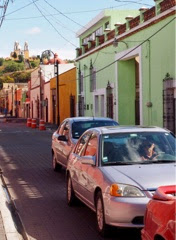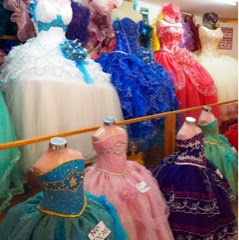The pyramid at Cholula, about thirty minutes from Puebla.
Bob and I are standing on top of the The Great Pyramid of Cholula, the largest pyramid in the world. It's much larger than the great pyramids of Egypt. A lot of excavation still has to be completed in order to see its immensity.
Before Eureopeans colonized the area, Cholula was a large city of Aztecs and the religious capital of highland Mexico. The Great Pyramid was built in four stages beginning around the 2nd century BC. The earliest structure was built in 100 BC and archeolgists have discovered painted insect-like designs in red, yellow and black.
The second structure, built right over the first, was very different with stairs covering all four sides so that people could get to the top from any direction. Indigeneous people, the Toltecs, conquered this area in 1200 AD and left the huge pyramid to the ravages of weather. By the time the Spanish conquered Cholula in the 1500s, the Great Pyramid looked like a wonderful hill top site for a Roman Catholic church.
One of the objects uncovered in the pyramid ruins is a 165-foot long colourful mural of life-sized human figures. It has been called "The Drunkards" because it depicts inebriation probably from a hallucinogenic potion from mushrooms. So we've been enjoying getting high for a long time.
Cholula is a big city now.
The church, way in the background, is built on top of the pyramid.
The city gets in the way of a good photo.
A beautiful church even though the Spaniards killed 6 000 Aztecs after they arrived.
Rings of fruit bread are still on sale.
It's a treat that there are no street dogs at all and almost no garbage. Mexico is suffering a lot from the effects of NAFTA and of course gangs and violence driven mostly by our drug culture. I think by providing some free university, the government is moving in the right direction.
We'll remember Puebla for its beautiful tile, clean streets and churches. Oaxaca has more music, theatre and art galleries than here and I miss that culture in Puebla. Something strange though, we've seen only one pregnant woman (today) since arriving in Mexico.
Plastic sheep and --
Beauty.
As we walked into our hotel tonight, I looked up to the brightly lit cathedral high above and thought of the deer and wild turkies on our lawn in Caledon. It will be good to sleep in our own beds tomorrow night. We are all so lucky to be living where we are and with what we have.
Gymnasts at The Tree of Life. We are all connected.
We are on the Estrella Roja bus en route to the airport in Mexico City. Keep enjoying yourselves and be well. Lynda































































